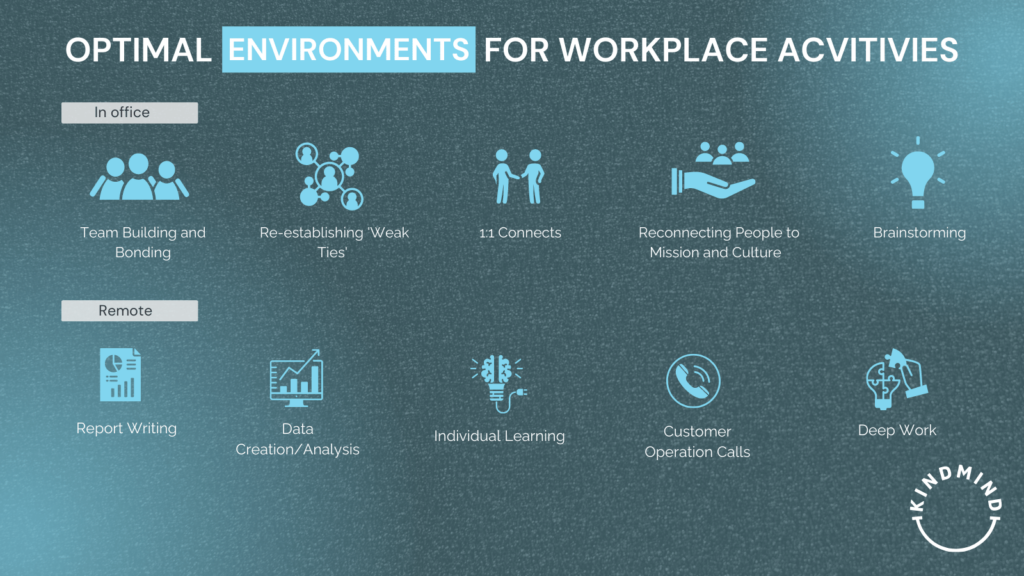Our working landscape has changed. No longer is it confined to one physical location. Instead, it is wherever the work gets done best.
Most of us are now familiar with remote and hybrid working models. However, how many of us truly know the impact these environmental changes have on the performance of our staff and business?
Let’s see if we can create a better roadmap to help us optimise the hybrid working model in 2023.
Optimising the hybrid working model: The state of hybrid working
We find ourselves in a dichotomy. A lot has changed since remote work began in 2020. Three years later, we all feel hybrid work has brought benefits and hindrances to the success of our workforce. Leading us to ask the question, “Is hybrid work still something we should offer?“
Looking into the research, something we like to do here at Kind Mind, we found several points worth discussing.
A Stanford University study found that remote workers saw a productivity boost equal to an additional full day’s work (annually) when staff were based in quieter environments with fewer breaks (Bloom et al., 2015).
Remote work has also improved job satisfaction due to increased flexibility, lack of commute, and better work-life balance. 29% of remote workers in one study were likelier to report being happy in their jobs over their on-site counterparts due to remote work.
While the flexibility of remote work can reduce stress and increase happiness, challenges with balancing work and life still occur. One study reported that feelings of isolation and the lack of a defined workspace can actually increase stress (Kossek et al., 2006).
In particular, the lack of face-to-face interaction and coordination has caused productivity to suffer for some businesses (Bernard et al., 2020). The absence of informal, casual interactions that occur naturally in an office setting can make remote workers feel left out and isolated (Buffer, 2020).
We feel that organisational support could be improved. If, as leaders, we understand how to motivate and support our team, wherever they are, that has to be the best solution to the hybrid problem.
But how do we do that? How do we add management tasks that bring our teams back together, even if they aren’t in the same space?
The Kind Mind guide to optimising the hybrid working model
In the evolving landscape of hybrid work, businesses often need help to balance in-person and online activities.
So here is a playbook you can use to help navigate this terrain.

In the office
- Team building and bonding – In-person interactions foster stronger bonds, boosting productivity, creativity, and well-being. Design compelling on-site experiences like professional development opportunities and guest speaker sessions. Build rituals that connect people and teams.
- Re-establishing’ weak ties’ – The office is a great place to strengthen those outer-ring network connections often lost in remote work. Schedule regular in-person events that include cross-organisational teams and departments.
- Reconnecting people to mission and culture – The physical workplace embodies company culture. New hires must experience this firsthand. Redesign meeting spaces for hybrid collaboration and provide opportunities for informal connections.
- 1:1 connects – Sensitive conversations are always best face-to-face. Allow managers to personalise individual feedback systems to discuss career development, team dynamics, and personal well-being.
- Brainstorming – The immediacy of in-person interactions can enhance brainstorming sessions. Staging day-long sessions for the team to discuss long-range goals, overlooked opportunities, and potential obstacles.
Essentially, when your team is in-house, have them explore deeper connections. Let them take away those positive memories and use them to fuel their days out of the office.
Remote
- Report writing – Remote work provides a quiet and controlled environment, free from the typical distractions of an office setting. Writing allows for deep focus, making it ideal for tasks like report writing that require concentration and attention to detail.
- Data creation/analysis – Data tasks often require uninterrupted focus. In a remote setting, you can control your environment to minimise distractions, making diving deep into data creation and analysis easier. Plus, all the necessary digital tools are readily available and often more easily accessible than in an office.
- Individual learning – Remote work allows flexibility in scheduling, which can be particularly beneficial for individual learning. You can choose the time that suits you best, whether you are a morning person or a night owl. Plus, online resources and learning platforms are readily available.
- Customer operation calls – Remote work can provide a quiet, private space for sensitive customer operation calls. It also allows for flexibility in scheduling these calls across different time zones. Digital tools can help keep track of customer information and previous interactions, making the service more personalised and effective.
- Deep work – Remote work is ideal for deep work – tasks that require intense focus and concentration. You can dive into complex problem-solving, creative thinking, or strategic planning without typical office interruptions. Plus, you can structure your day around your most productive hours rather than sticking to a traditional 9-5 schedule.
When your team works remotely, have them concentrate on project work, something that stimulates their sense of achievement either in bursts of productivity or work quality. This brings them back to the office in a positive mood, ready and confident to contribute to teamwork.
Ok, now we have some ideas on what tasks to implement; how do we ensure our leadership and staff are ready to tackle them?
Assessing your organisation’s readiness for culture change
Before diving into any workplace culture change, assessing your organisation’s readiness is crucial.
Gaining support from top-level executives and managers isn’t just about buy-in; it’s also about a mindset shift. If your people can see the benefits and appreciate the work to get there, they will likely embrace change. For some of your leadership, this will be a systemic change, so it is essential that you learn to support their needs during this time.
You’ll also need employee backing. Solicit employee feedback to understand their preferences, concerns, and expectations regarding hybrid work. This insight will help tailor your approach to suit your team’s needs.
Once you have your people onside, it’s time to revisit your hybrid working policy and reshape your working charter. Remember, while remote and hybrid working is still in its infancy, a lot has changed fast. You’ll also need to reconsider your workspace design and your tech setup.
Tackling employee well-being and engagement
We reeled off several challenges at the start of this blog post. While our guide tackled some of the issues around re-engagement and increases in productivity, we also know that a good deal of what your employees are going through is about the need for more robust emotional support. Positive mental health is a significant factor here.
Open your communication channels and show your team that discussing mental health is good. Offer holistic well-being services, like Kind Mind and Employee Assistance Programmes (EAPs) that include services like benefits.
Create a space where your team can feel supported in their work. Encourage open dialogue and active participation from all team members during meetings. Inclusive decision-making empowers employees and enhances their sense of belonging.
Keep a closer eye on workload distribution. Allow autonomy, but not to the extent of team losses or individual burnout.
Recognise and appreciate employees’ efforts and achievements, regardless of their physical location. Celebrate successes and milestones to boost morale and motivation further.
Give your team an understanding of what makes a balanced work-life approach
Physically “going to work” is still ingrained in us all. We have yet to get used to remote and hybrid working. And of course, that’s only natural; it’s only been three years.
Help your employees to appreciate what work-life balance looks like. Help them set clear boundaries for communication and to disconnect from work-related devices during designated personal time. Let them “step out of the office”.
Create a workplace where regular breaks and vacation days are more than just a reward, but a right. You’ll see higher engagement and less absenteeism and presenteeism as a result.
Allow employees to choose a hybrid schedule that suits their needs. A flexible approach empowers them to structure their workday to align with personal preferences.
Measure hybrid working ROI with care
The effectiveness of your new hybrid work model ROI will depend on several things:
- Moving away from monitoring hours worked and focusing on outcome-driven metrics that assess the impact and quality of work delivered.
- Implementation of a 360-degree feedback system to gain a holistic view of employee performance. Include feedback from peers, managers, and subordinates to provide well-rounded evaluations.
- Conducting regular performance reviews that acknowledge accomplishments, provide constructive feedback, and identify areas for growth and development.
- Understanding employee wellness and how to measure it effectively.
Most of all, it’s about appreciating that change is a transition, which means monitoring and adapting leadership and team approaches to new situations.
Conclusion: Optimising the hybrid working model for 2023 and beyond
In the dynamic landscape of modern work, the hybrid working model presents an incredible opportunity for decision-makers, employers, and business owners to revolutionise workplace culture and employee engagement. By optimising your hybrid work environment, you can unlock a powerful blend of flexibility and productivity, enhancing job satisfaction and overall performance.
Throughout this roadmap, we have explored the essential components of optimising the hybrid working model for 2023 and beyond, from embracing the advantages of hybrid work to fostering change within your organisation to tackle its challenges. We hope you have found a reason and a valuable tool to adapt to modern employment.
Are you eager to optimise your workplace success? Read Kind Mind’s blog for more insightful guides on achieving excellence in employee engagement, productivity, and job satisfaction!






